1839

University of Missouri founded
Established in 1839, the University of Missouri was the first public university west of the Mississippi River. Image courtesy of the Library of Congress.
1862
Morrill Act
Morrill Act creates state colleges of agriculture.
1870
MU College of Agriculture and Mechanical Arts founded
1870

George Clinton Swallow appointed as the first Dean of the MU Agriculture and Mechanical College
https://cafnr.missouri.edu/2012/11/border-ruffian-savant/
1870
First students enrolled
1871

Switzler Hall was built
The first classes for the new MU College of Agriculture and Mechanical Arts were held here. It was originally named Scientific Hall, then Agricultural Hall.
1872
Mizzou tests new mass-produced plows
Mizzou tests new mass-produced plows and cultivators and shares results with farmers
1873
First students graduated
1876
Entomologist C.V. Riley helped save French wine industry with Missouri rootstock
1880

Henry Kirklin, the University’s first Black teacher, teaches how to prune and graft plants
Henry Kirklin (1858-1938) was a former enslaved person who became a prize-winning gardener and horticulturist and a successful businessman. After joining the University of Missouri’s horticulture department as a gardener and greenhouse supervisor, he may have been the first African American to teach at the university, although in an informal, unofficial capacity, as the university did not allow Black people to hold official teaching positions during his lifetime.
1882

J.W. Sanborn became dean
1885
First U.S. vaccine-virus lab established
Agriculture’s veterinary science department establishes first U.S. vaccine-virus lab.
1887
Hatch Act established agricultural experiment stations
Hatch Act established agricultural experiment stations at land-grant universities.
1888

J.W. Sanborn establishes Sanborn Field (then called Rotation Field)
1888

Agricultural Experiment Station (AES) was created within the college to develop the agricultural sciences by practical research
AES was created within the college to develop the agricultural sciences by practical research
1889

Edward D. Porter became dean
(1889-1895)
1890
College of Agriculture published bulletins to share research discoveries with farmers
1891
First agriculture graduate student at Mizzou
1892

Swallow Hall constructed
Natural resources and some ag classes were taught here. The building is named for the first dean of MU agriculture, George Swallow.
1893
Animal science experts created vaccine for Texas Fever
Animal science experts determine that Texas Fever is caused by ticks and created a vaccine to eradicate the cattle disease.
1894

Agricultural Chemistry becomes first department in the College of Agriculture
1894
Mizzou Anti-Hog Cholera Serum plant opens
1895

H.J. Waters became dean
(1895-1909)
1896
Dunn-Palmer Herbarium founded
Dunn-Palmer Herbarium became the first plant library west of the Mississippi.
1901
Dairy science building built
Later expanded and renamed Eckles Hall in honor of Clarence Henry Eckles in 1938
1901
First four-year course in agriculture developed
1901
College adds to curriculum
Colleges adds dairy husbandry, animal husbandry, agronomy, farm management, field crops, soils and agricultural engineering to curriculum.
1903

First short courses offered
Short courses were popular because they lasted only eight weeks and were held during the winter, a slow time of the year for farmers.
1904

Animal husbandry department formed
In 1904 most Missouri farmers raised livestock, so the department worked closely with livestock producers. This trend of working with livestock producers has continued through the years.
1905
First MU Livestock Judging Team
1906

Farmer’s Week began
Farmer’s Week was popular for decades until World War II when the draft and gasoline rationing affected attendance.
1909

Dairy chemistry lab, Eckles Hall
1909

Home economics class
1909

Frederick Blackmar Mumford became dean
(1909-1938)
1910
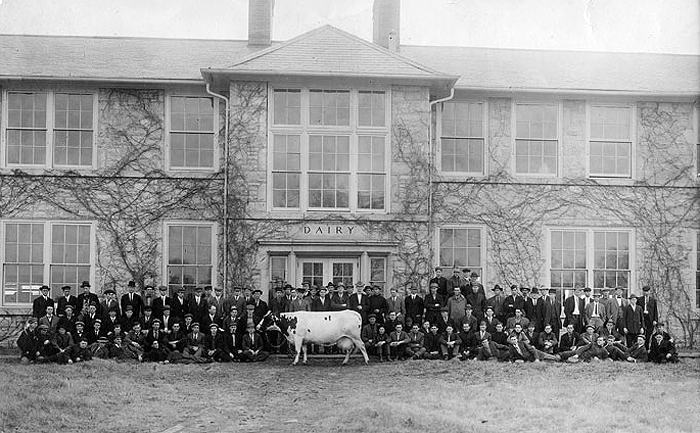
Dairy cow Chief Josephine produces a record 15,725 pounds of milk in one year
1910
Department of Farm Management established
1910
MU Extension spread research results to citizen of Missouri
1911

Poultry Husbandry Department established
1911
College of Agriculture began research on soybeans
College of Agriculture begins research on soybeans, a $6 billion Missouri industry today.
1912
Special trains journey through Missouri sharing research discoveries with farmers
1913
College of Agriculture faculty answer 109,557 questions from Missouri farmers
1914
Department of Soils formed
The new department was housed in Mumford Hall.
1914
Smith-Lever Act established
Smith-Lever Act established cooperative extension to inform about agriculture developments
1915
Dean Mumford directed projects to boost production
Dean Mumford directs project to boost production from 22 to 44 bushels per acre to help war effort.
1917
M.F. Miller studies soil and water loss under different cropping systems
1919
President Wilson picked Fredrick Mumford to help rebuild French agriculture
1922
College’s Clover and Prosperity program fights soil erosion
1923
Agriculture enrollment hit 700
1926

Memorial Union’s first phase of construction completed
Today, the University of Missouri’s Memorial Union is a campus icon that remembers soldiers who died in battle. The concept came from a poem written by a MU College of Agriculture graduate who perished in World War I. Robert McGhee “Peaches” Graham (1892 – 1918) and his Army friends wrote the poem, which calls for the construction of a bell tower on the MU campus to memorialize the University’s war dead. Photo of Bell Tower construction courtesy University Archives.
1927
Lewis Stadler discovers radiation multiples mutations in plants
Lewis Stadler discovers radiation multiples mutations in plants, a break though leading to faster development of new crop varieties.
1928
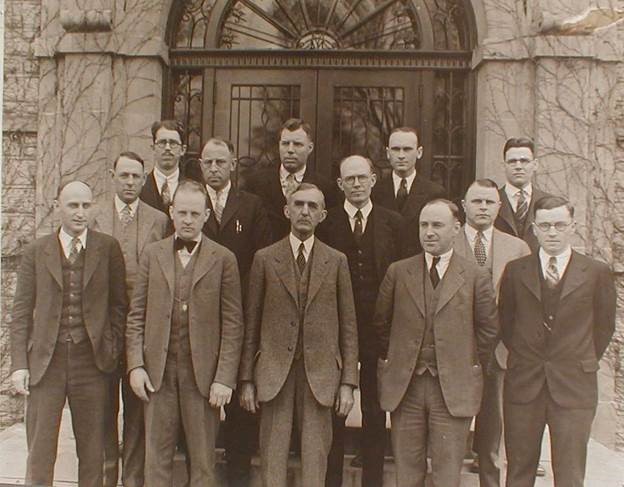
Early Leaders of the College
Picture of the faculty of the Department of Animal Husbandry at the University of Missouri taken in 1928 or 1929. Front row (from left) – Jim Burch, Jim Foster, Frederick B. Mumford, EA Trowbridge, and Fred F. McKenzie; Middle row (from left) – L.A. Weaver, T.A. Ewing, A.G. Hogan, and D. Chittenden; Back row (from left) L.E. Casida (PhD student), H. Garlock, H. Moffett, and J.E. Comfort.

M.F. Miller became dean
(1938-1945)
1938
Mizzou Agricultural Library among largest in nation
1943
“Woody” Woodruff is first researcher to break 100 bushel per acre barrier
1944
Leonard Haseman and L.F. Childers perfect diet to protect bees
Leonard Haseman and L.F. Childers perfect a diet that protects bees from a disease that threatens to wipe out nation’s bee colonies.
1945

Aureomycin discovered
1945

E.A. Trowbridge became dean
(1945-1948)
1947
Department of Forestry established
The department was housed in the Agriculture Building and was elevated to the status of School of Forestry in 1957.
1948

First MU Livestock Judging Team with a female participant
1948

J.H. Longwell became dean
(1948-1960)
1952

Foremost Dairy Research Center was built through a generous donation from J.C. Penney
The center was named after his famous bull, Langwater Foremost.
1952
Ernest and Lotti Sears developed a wheat strain resistance
Ernest and Lotti Sears developed a wheat strain resistant to rust disease – strain became a worldwide food source.
1953

Horticulture Research Center opens
The Horticulture Research Center became the Horticulture and Agroforestry Research Center (HARC) in 1995.
1954
Agricultural faculty help set up Indian agricultural universities
1955
Thompson Farm established
Thompson Farm was established in 1955 through the will of Dr. George Drury, a retired dentist. The terms of the will prescribed that the farm should be “dedicated to public educational purposes in memory of Eulah Thompson Drury, Guy A. Thompson, Paschall W. Thompson and Olive F. Thompson.”
1957
Gyorgy Redei indentified Arabidopsis as a model
Gyorgy Redei identified Arabidopsis as a model of flowering plant genetics, which becomes a standard worldwide.
1958
Delta Research Center opens in Portageville
1959

Farmers tour the new Bradford Research Farm
1959
Research began on herbicide Treflan
1960
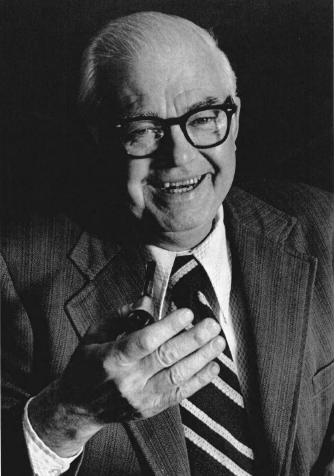
Elmer R. Kiehl became dean
(1960-1979)
1961

Ag Building dedicated
1964

Sanborn Field added to National Register of Historical Places
1965
Forage Systems Research Center was established
The primary research objective is the development and evaluation of forage systems for all classes of beef cattle.
1965
Six new Missouri cotton varieties developed
1967
Department of Atmospheric Science formed
The new department was housed in Gentry Hall.
1969
Hospitality Management program was established
It was then called Hotel and Restaurant Management. The program name changed in 2011 to reflect how the hospitality industry has grown and developed.
1969
MU Animal Science Research Center construction began
1973
Fisheries and Wildlife program becomes part of Natural Resources
The program was originally established in 1937 in the College of Arts and Sciences, and was housed in Stephens Hall.
1974

Greenley Research Center dedicated after Hortense Greenley donates 700-acre farm
1976
MU Biochemistry created as a joint affiliation between the School of Medicine and CAFNR
For decades, faculty at the University of Missouri’s Department of Biochemistry had one collective goal — to study life at the molecular level — but were in two separate units, one housed in CAFNR under the name agricultural chemistry and one in the School of Medicine under its current name.
1980

Max Lennon became dean
(1980-1983)
1983

Animal and poultry science departments merge; single undergraduate curriculum in animal, dairy and poultry science created
1983

Roger Mitchell became dean
(1983-1998)
1984
Food & Agricultural Policy Research Institute (FAPRI) established
1989
School of Natural Resources created
1989
Animal and dairy science departments merged to form the animal sciences unit
1995
Ernie Soft Red Winter Wheat announced
1996

Construction of the Anheuser-Busch Natural Resources building
1998
The MU Center for Agroforestry established
The MU Center for Agroforestry is one of the world’s leading centers in agroforestry research.
1998
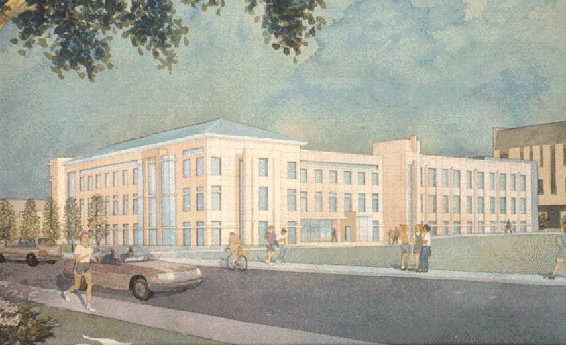
Anheuser-Busch Natural Resources Building dedicated
1999
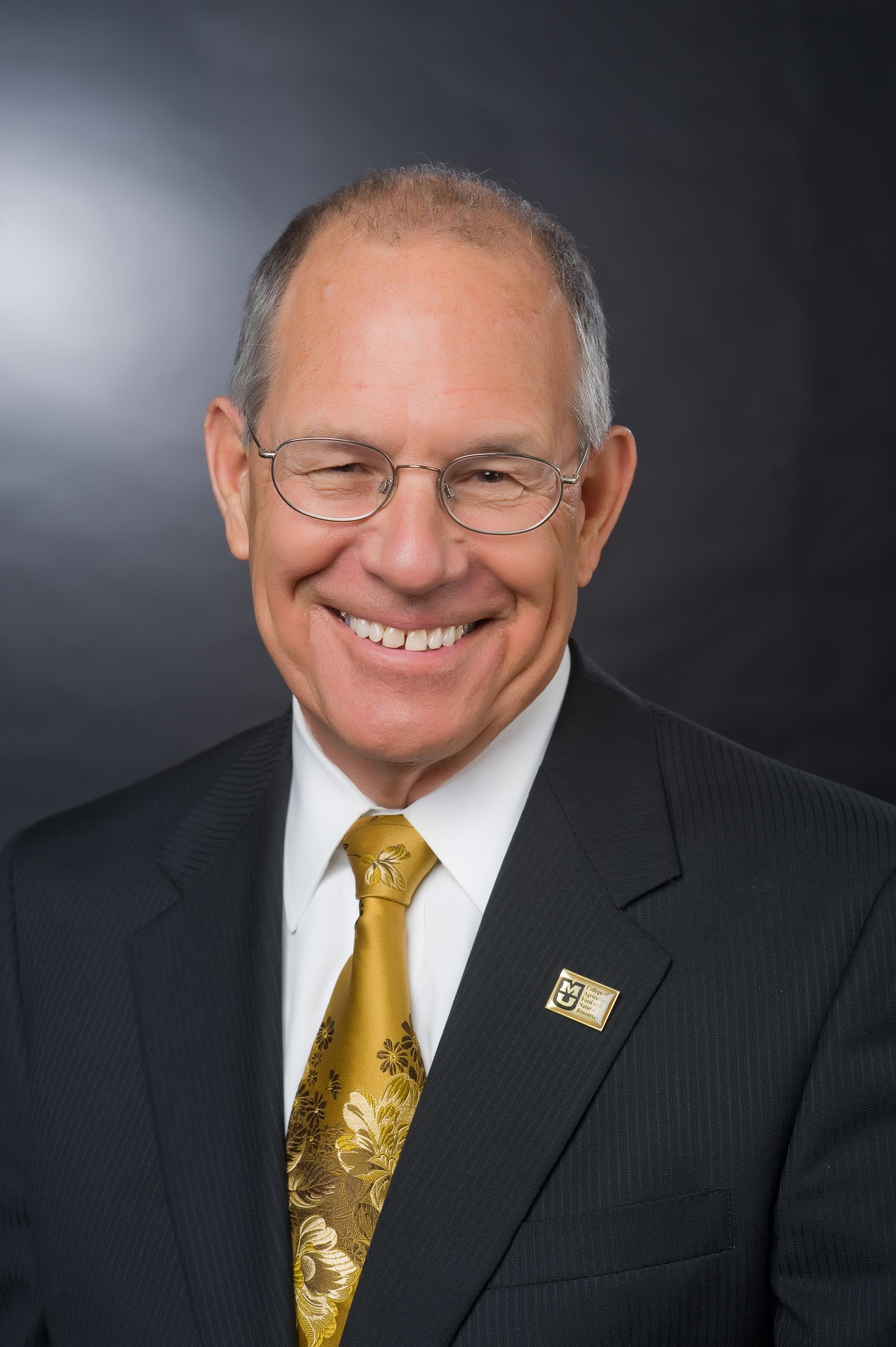
Thomas L. Payne became dean
(1999-2016)
2000
Bioengineering Department created as a jointly affiliated unit between CAFNR and the College of Engineering
2000
Randall Prather cloned first pig
Randall Prather cloned first pig in which a gene that causes human rejections “knocked out” of the DNA.
2005
Bruce McClure determined molecular mechanism
Bruce McClure determined molecular mechanism by which flowering plants recognize which pollens are appropriate for fertilization.
2005
The Division of Plant Sciences formed
New division was formed through the consolidation of the former departments of Agronomy, Entomology, Horticulture, and Plant Microbiology and Pathology.
2009
Monty Kerley identifies cattle that achieve weight goals on less feed
2010
CAFNR enrollment surpasses 3,000 students
2011
CAFNR scholarships top $1 million
2012
Mizzou’s $75 million woody biomass boiler goes online, replacing polluting coal
2012
Missouri’s first drought simulators open
2019

Drive to Distinction – CAFNR Strategic Plan Launched
Missouri is fortunate to have strong agriculture, natural resource, financial and healthcare industries as allied partners to provide CAFNR, as part of Missouri’s land-grant university, an opportunity to affect the lives of every citizen by providing unbiased, relevant and accessible education, information and resources.
2017

Christopher R. Daubert became dean
(2017 – present)
2019

CAFNR officially opens Land of the Osages Research Center
This new center, the first center to open in more than 30 years, will further research in agroforestry, a sustainability-focused system that combines trees and shrubs with crops.
2019

About the future from Vice Chancellor and Dean Christopher Daubert
“Massive changes are happening in agriculture and natural resources,” Vice Chancellor and Dean Daubert says. With the world’s population projected to increase to 9 billion by 2050, along with rapidly changing climates, it’s up to science to help communities adapt, he says. “As a land-grant institution, we work hard to share current technologies with our students and Missourians. But we also must go beyond that and teach next-generation practices that will keep our agriculture and natural resource industries thriving and striving to be on top far into the future.”
2020

CAFNR celebrates 150 years of serving Missouri and the world
2020

Founding Day 150th Celebration
CAFNR’s Founding Day celebration was Feb. 24, 2020.
2021

On the Drive: Biennial Report 2021 Released
This report shows the progress made over the first two of the six years.
2023

In High Gear: Biennial Report 2023 Released
This report shows the progress made over the first four of the six years.